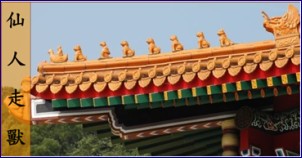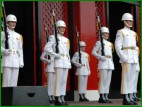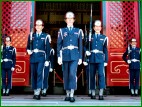| National
Revolutionary Martyrs' Shrine¡ÐLearning Sheet for School-based
Curriculum Development of Dazhi High School

National Revolutionary Martyrs' Shrine is located on Bei-an
Road in Dazhi District, resting among Grand Hotel and numerous
military institutions. Former Martyrs' Shrine was Taiwan
Huguo Jinja during Japanese Occupation. Martyrs' Shrine enshrines
brave patriotic martyrs who died for our nation in battles
or wars. The architecture shares the same palatial style with
Beijing's Tai-he Palace. The grand architecture and the fabulous
Guard Mounting performance together make Martyrs' Shrine
a military institution with historical and cultural value.
How much do you know Martyrs' Shrine? Visit Martyrs' Shrine
by yourself and take a look at the following reference. Finish
this learning sheet and hand it in to your instructor.
 |
(1)Archway
Entrance:
Three-door concrete structure covered with indigo
glazed ceramic roof tiles. It is the entrance of National Revolutionary
Martyrs' Shrine.
(2)Bell Tower and (3) Drum Tower:
An octagonal pagoda, covered with indigo glazed ceramic roof
tiles. There is a bronze statue of a martyr inside each tower.
There is a bell on the second floor of the Bell Tower and a
drum in the Drum Tower. The second floor of Bell Tower and Drum
Tower are not open to the public. During national memorial,
only related personnel are allowed to enter.
(4) The
Main Gate:
The Main Gate is a concrete structure, covered with yellow glazed
ceramic roof tile. Among the beams and pillars are painted with
dragons pattern. The door head identifies ancient royal style.
Four hexagon objects on the door head are called the ¡§door
viewer,¡¨ which signifies the pedigree of the architecture in
ancient China. In front of the Main Gate are a pair of stone
lions carved with marble. Each stone lion weighs eight tons.
The one that holds a ball is the male lion, while the one with
a baby lion is the female lion.
(5)Main
Hall:
The Main Hall is a concrete northern-palace
style architecture. The roof style of the Main Hall is called
Wu-Dian. This one is covered with yellow glazed ceramic roof
tiles, which symbolizes the highest social ranking in Ancient
China. The roof ridge is decorated with a celestial and several
mythical animals. Both dou-gongs (brackets) and dragons patterns
among the beams and pillars follow the exact style of Liang
Sicheng's Construction manual of Qing. It is built mainly for
worshipping martyrs who helped founding our country. The martyrs'
tablets are placed in the shrine in the Main Hall. On the left
hand side of the shrine is the tablet of Chinese people's ancestor,
Yellow Emperor, while on the right is the portrait of Dr. Sun
Yat-sen, our nation's founding father.
According to the enactment of the National Revolutionary Martyrs'
Shrine Management Section, Reserve Command, two national memorials
are held in Martyrs' Shrine each year, spring national memorial
and autumn national memorial. Spring national memorial takes
place on March 29th, Youth Day, in combination with memorial
service of Tomb Sweeping Day(April 5th) each year. Autumn national
memorial is held on September 3rd, Armed Forces Day. President
would officiate the national memorial with premiers of Executive
Yuan, Legislation Yuan, Judicial Yuan, Examination Yuan and
Control Yuan, inviting families of enshrined martyrs and relevant
officials to pay their highest respect to the martyrs.
(6) Literati
Martyrs:
The roof of Literati Martyrs' Shrine is covered with
yellow glazed ceramic roof tiles. Among its beams and pillars
are painted with dragons pattern. Literati Martyrs' Shrine
enshrine martyrs or intellectuals who died for founding the
nation, denouncing President Yuan Shi-Kai for his treason, guarding
the Constitution, fighting in War of Resistance Against Japan,
and suppressing rebellions. Martyrs like Lu Haou-Dong, Lin Chio-Min,
Soong Jaou-Ren, Chu Zhi-Hsin, Lo Fu-Hsin, and the 72 Huanghuagang
Revolutionary Martyrs as well as Taiyuan Five Hundred Perfect
Men are enshrined here.
(7) Military
Martyrs:
The Military Martyrs' Shrine enshrines soldiers and
military officers who died in the Eastern Expeditions, the Northern
Expeditions, Anti-communist Campaigns, and suppressing rebellions.
Generals are enshrined with an individual tablet, field officers
are listed on hundred-person tablet, while privates are en masse
in patriot rosters in storage.
You can appreciate the beauty of northern-palace style architecture
without crossing the strait to Mainland China because there
is already one in Dazhi. Be sure to pay attention to observe
the delicate structural details in Martyrs' Shrine. Generally,
architecture of northern-palace style emphasizes more on its
momentum. Therefore the architecture's roof decoration has
an important function of symbolizing the social ranking and
the degree of auspice. Even if you don't know much about historic
monuments, you can still understand and appreciate the delicate
roof a little through the following introductions.
Roof Ridge:
Zhengwen is the intersect of the main ridge and diagonal ridge
gripped by two mythical animals. Usually the mythical animals
can be an owl, a fish, or a hornless dragon, which according
to Chinese mythology has super power to suppress the fire god.
A sword is on each of these mythical animals' back to prevent
the end of the ridge from fire.
Roof Tiles:
The roof of Forbidden City is composed of glazed ceramic tiles.
Yellow ceramic roof tiles are reserved for the emperor. It is
of the highest status, and can only be used in imperial palaces
and temples. The following colors of galzed ceramic roof tiles
according to its social rank are green, blue, red, purple, and
black.
Roof Decoration:
The celestial being and several mythical animals
on the roof ridge indicate the royal status of the resident.
Traditionally, its order on the roof the celestial, the dragon,
the phoenix, the lion, the heavenly horse, the sea horse, the
legendary beast of prey, wind-and-storm-summoning fish, a legendary
unicorn-beast, the bull and the monkey. The numbers of animals
represent the rank of the palace. The higher the number is,
the higher the status of the building is, and vice versa.
 |
Please
count how many mythical animals are on the roof? Ancient
eaves tile(Wa-tang) is placed at the end of round tiles.
Do you know what pattern is on wa-tang? Drip tiles are
fixed between two wa-tangs, also known as rain tiles,
because rain falls from here. Go to Martyrs' Shrine
and check the shape of the drip tiles. |
 |
 |
 |
 |
| Army
Uniform |
Summer
Navy Uniform |
Winter
Navy Uniform |
Air
Force Uniform |
Every four months, Guard Mounting
is performed alternately among National Revolutionary Martyrs'
Shrine, Chiang Kai-shek Memorial Hall and Sun Yat-sen Memorial
Hall by the honor guards of Army, Navy and Air Force. This performance
often attracts numerous tourists. Different forces wear different
uniform with particular gun handling style. Which one do you
see? The honor guards change every hour from 9 a.m. to 5 p.m.
If you want to watch Guard Mounting performance, be sure to
be on time!
Last but not least, remain silent when you enter the Main Hall,
the Literati Martyrs' Shrine and the Military Martyrs' Shrine
in order to express your respect to the martyrs.
Source: http://www.dcsh.tp.edu.tw/shrine
An Introduction to Traditional Taiwanese Southern-Min Style
Architecture: http://www.course.cs.tku.edu.tw/~cbrpk87u/trad/trad.htm
Website Translated
by Ou Yang Pei-ting(  Top )
Top ) |
|